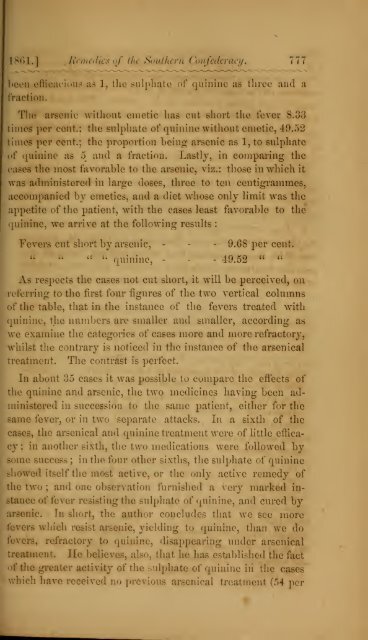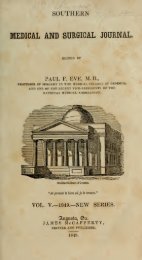Issue 10, pp. 753-832, October 1861, SMSJ
Issue 10, pp. 753-832, October 1861, SMSJ
Issue 10, pp. 753-832, October 1861, SMSJ
Create successful ePaper yourself
Turn your PDF publications into a flip-book with our unique Google optimized e-Paper software.
<strong>1861</strong>.] Renu the Southern Confederacy. 777been efficacious as 1, the sulphate of quinine as three and afraction.The arsenic without emetic has cut short the lever vtimes per cent.; the sulphate of quinine without emetic, 49.52times per cent.;the proportion being arsenic as l,to sulphateof quinine as 5 and a fraction. Lastly, in comparing thea the most favorable to the arsenic, viz.: those in which itwas administered in large doses, three to ten centigrammes,accompanied by emetics, and a diet whose only limit was thea<strong>pp</strong>etite of the patient, with the cases least favorable to thequinine, we arrive at the following results :Fcvcr< cut short by arsenic, - - - 9.6S per cent.•quinine, - - 49.52 " "As respects the cases not cut short, it will be perceived, onreferring to the first four iigures of the two verticalcolumnsof the table, that in the instance of the fevers treated withquinine, the numbers arc smaller and smaller, according aswe examine the categories of cases more and more refractory,whilst the contrary is noticed in the instance of the arsenicaltreatment. The contrast is perfect.In about 35 cases it was possible to compare the effects ofthe quinine and arsenic, the two medicines having been administeredin succession to the same patient, either for thesame fever, or in two separate attacks. In a sixth of thesenical and quinine treatment were of little efficacy:in another sixth, the two medications were followed by: in the four other sixths, the sulphate of quinineshowed itself the most active, or the only active remedy ofthe two ;and one observation furnished a very marked instanceof fever resisting the sulphate of quinine, and cured bymic. In short, the author concludes that we see morers which resist arsenic, yielding to quinine, than we dofevers, refractory to quinine, disa<strong>pp</strong>earing under arsenicaltreatment. lie believes, also, that h< ablished the factof the greater activity of the sulphate of quinine in the caseswhich have received no previous arsenical treatment (T>4 per








